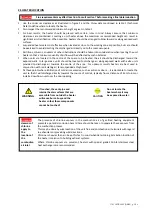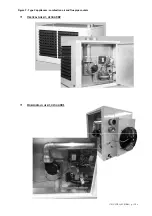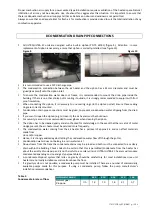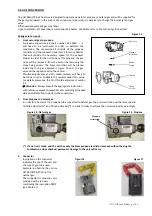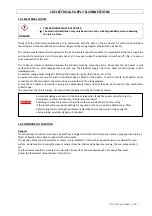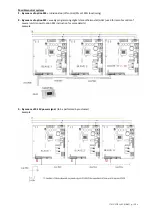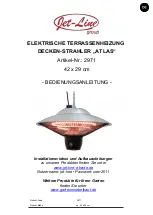
1701ULTRA(EC)GBEN, p. 5/29
2.5
HEATER
LOCATION
Attention
Flue
requirements
may
affect
location.
Consult
section 7 before
making
a
final
determination
.
Use
the
minimum
clearances
as
illustrated
in
figure
2
and
the
throw
data
mentioned
in
table
1
(Technical
Data)
to
define
where
to
locate
the
heater.
Also
respect
the
recommended
minimum
height
as
given
in
table
1.
For
best
results,
the
heater
should
be
placed
with
certain
rules
in
mind.
Always
ensure
that
minimum
clearances
are
maintained.
Locating
a
unit
heater
above
the
maximum
recommended
height
can
result
in
significant
air
stratification.
When
possible,
heaters
should
be
arranged
to
blow
toward
or
along
exposed
wall
surfaces.
Suspended
heaters
are
most
effective
when
located
as
close
to
the
working
zone
as
possible,
but
care
should
be
exercised
to
avoid
directing
the
discharged
air
directly
on
to
the
room
occupants.
Partitions,
columns,
counters
or
other
obstructions
should
be
taken
into
consideration
when
locating
the
unit
heater
so
that
a
minimum
quantity
of
airflow
will
be
deflected
by
such
obstacles.
When
units
are
located
in
the
centre
of
the
space
to
be
heated,
the
air
should
be
discharged
toward
the
exposed
walls.
In
large
areas,
units
should
be
located
to
discharge
air
along
exposed
walls
with
extra
units
provided
to
discharge
air
towards
the
centre
of
the
area.
For
optimum
results
heaters
are
best
used
in
conjunction
with
recirculating
air
fans
suspended
at
high
level.
At
those
points
where
infiltration
of
cold
air
is
excessive,
such
as
entrance
doors
...
it
is
desirable
to
locate
the
unit
so
that
it
will
discharge
directly
towards
the
source
of
cold
air,
typically
from
a
distance
of
4.5m
to
6m
or
install
a
downflown
unit
over
the
door
opening.
WARNING
If
touched,
the
vent
pipe
and
internal
heater
surfaces
that
are
accessible
from
outside
the
heater
will
cause
burns.
Suspend
the
heater
so
that
these
components
cannot
be
touched!
CAUTION
Do
not
locate
the
heater
where
it
may
be
exposed
to
water.
Attention
Hazards
of
chlorine
apply
to
the
location
of
the
combustion
air
inlet
The
presence
of
chlorine
vapours
in
the
combustion
air
of
gas
‐
fired
heating
equipment
presents
a
potential
corrosion
hazard
Care
should
be
taken
to
separate
these
vapours
from
the
combustion
process.
This
may
be
done
by
wise
location
of
the
unit
flue
and
combustion
air
terminals
with
regard
to
exhausters
or
prevailing
wind
directions.
Chlorine
is
heavier
than
air.
Keep
this
fact
in
mind
when
determining
installation
location
of
the
heater
in
relation
to
building
exhaust
systems.
Where
chlorine
vapours
are
prevalent,
heaters
with
special
grade
316
AISI
stainless
steel
heat
exchangers
are
recommended.





